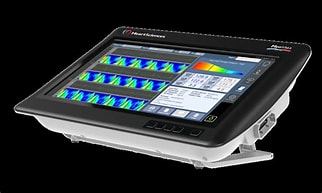(i) BioSensors
With full Anthropo-Biometric Body Model, and a Virtual Image of the real human in place, the stage is set to relate the same with the actual human especially the brain and the signal (nerve) system, together with other auxiliary processes e.g. the blood system. A correlation of these is the ultimate confirmation and ticket for accuracy and reliability of the Anthropo-Biometric Career Assessment and Forecasting process. Biosensors are a neural interface technology that detect nerve and muscle activity.
Currently, biosensors exist that measure muscle electrical activity, brain electrical activity, and eye movement. Biosensors are electrodes that sit on the skin over the muscle or nerve being sampled. Modern developments in microelectrode biosensors now give unprecedented spatial and temporal resolution, enabling, for the first time, direct measurement in real time of the chemical conversations between cells in the nervous system. These can be related today to the anthropometric systems through sophisticated computer algorithms fitted with equally sophisticated statistical measures to provide the correlations and desired coefficients. A typical Talent Clinic should, therefore, have Biosensors (fixed or mobile) that can be used to detect, help in analysis and interpretation of brain and sensory activities.
(ii) Brain Metrics
In the determination of a person’s ability, and potential to perform identified tasks –talent/career – the brain and its coordination metrics are equally important and must be correlated to the results from the Anthropo-Biometrics of the 3D Optical Sensing cameras and related software engines outlays. A congruence of these (i.e. correlation exits) provides accuracy, reliability and confidence in career determination and forecasts. Accordingly, for better Career Forecasts Brain Metrics should be employed at a Talent Clinic. Brain Metrics refer to measures of brain content, activity and resultant meaning or implication to related body organs especially the heart and the nervous system.
There are many different methods to go about capturing information on brain structures and functions.
The three most common and most frequently used measures are :
(i) functional Magnetic Resonance Imaging (fMRI),
(ii) Magneto encephalography (MEG) and
(iii) Electroencephalography (EEG).
Of these methods, EEG is the most versatile and cost-efficient solution, that shoud be available at any Talent Clinic. This should be supplemented with Electrocardiographic (ECG) biosensors that will help in capturing heart rates/blood pressure, heart age, etc which are also key in correlation indices.
(iii) Sensory and Signal Metrics
Sensory-perceptual and motor functions are closely dependent on the integrity of the brain and nervous system. Standardized tests have been developed to assess these functions, and would be useful to evaluate candidates who are suspected of having a neuropsychological basis for their difficulties. Higher-level functions (such as verbal and academic abilities, executive functioning, etc.) are obviously important in producing successful performances, but the brain and nervous system correlates of these abilities should be more defined for the correlation of sensory-motor abilities and the Anthropo-Biometric outcomes.
With the development of a Multisensor-Based Non-Contact Anthropometric System for Early Signal Path Detection, it is now possible to link, through software engines, and correlate Virtual Anthropo-Biometric Body Models and the actual human signal paths.
General senses that would be captured by the biosensors include sight (visual), taste (gustatory), touch (tactile), hearing (auditory), and smell (olfactory). The others are vestibular (balance), proprioceptive (movement) and interceptive (internal). Individual scores of these are very important in determination and explanation of extra ordinary human abilities which are not psychometric in nature.
This is possible through The Integrated Psycho-path Software Engines that comprise the instruments of Artificial Intelligence and related Data Mining Techniques.

